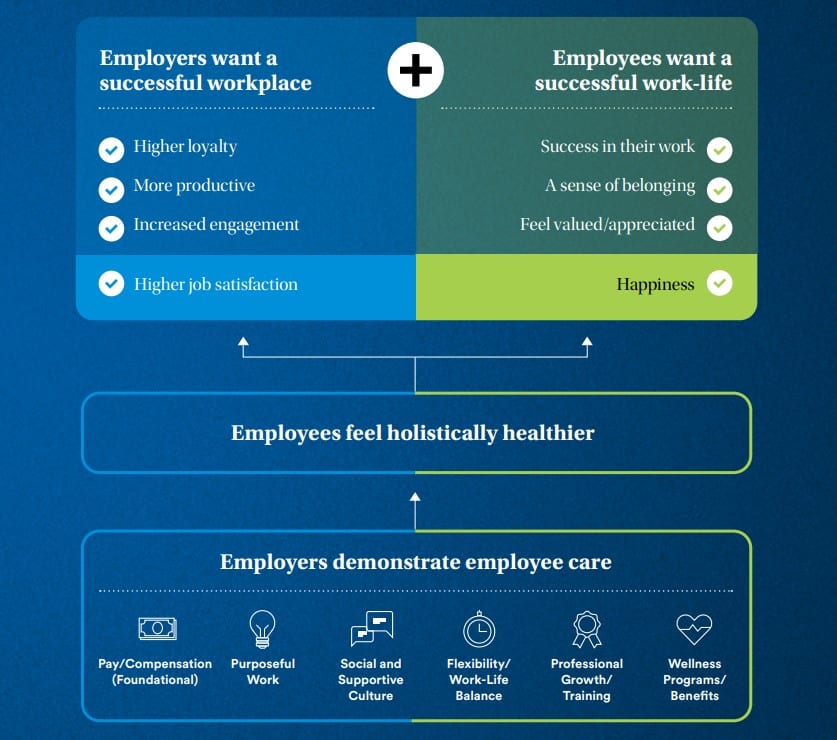Although we’d all like to think the pandemic is fully in the rearview mirror by now, complications born of that era of restricted lifestyle continue to manifest and reach new levels of complexity—and the workplace is becoming the petri dish where this scenario is unfolding. New research financial services firm MetLife’s finds employees are now more likely to experience negative feelings at work, including stress (12 percent more likely) and burnout (17 percent more likely) than they were pre-pandemic. Employees are also 51 percent more likely to feel depressed at work than they were pre-pandemic as they battle perceptions of living in an era of permanent and complex crises—known as a permacrisis state.
The firm’s 22nd annual U.S. Employee Benefit Trends Study (EBTS), based on two distinct studies fielded by global strategy, insight and planning consultancy STRAT7 Rainmakers, digs into this reality. In last year’s study, the firm unveiled “employee care” as a powerful tool for employers to support their workforce and organization. This year’s report finds delivering care during key work and life moments and prioritizing the role of benefits has an outsized impact on individuals and businesses alike. In fact, employees who understand and use their benefits are significantly more likely to feel cared for (88 percent) by their employer, compared to those who don’t (34 percent). In return, employees who feel cared for are 60 percent more likely to intend to be at their organization in 12 months and 55 percent more likely to feel productive at work.

“Today’s workforce is navigating the pressures of their day-to-day lives in parallel with ongoing macro challenges, and it’s impacting their overall wellbeing and how they show up at work,” said Todd Katz, executive vice president and head of Group Benefits at MetLife, in a news release. “As employees juggle a range of personal and professional demands, our research affirms employers must provide more tangible support—when and where it matters most.”
As work-life divides wane, gaps in care delivery emerge
The majority of employees have come to expect a more consistent delivery of care from their employers—not just at work (92 percent), but also in their personal lives (79 percent). Consequently, when employers provide support during key moments, employees are significantly more likely to feel cared for (76 percent vs. 45 percent).
 However, this year’s research unearthed care delivery gaps wherein employees report not feeling adequately supported by their employers, particularly during critical life moments with significant personal impact. This includes:
However, this year’s research unearthed care delivery gaps wherein employees report not feeling adequately supported by their employers, particularly during critical life moments with significant personal impact. This includes:
- Navigating unplanned financial stress: Among employees who went through a significant unplanned financial stress/expense, 86 percent said it had a high impact on them, but only 48 percent of them felt that their employer demonstrated care during the experience.
- Experiencing a mental health condition: 81 percent of employees who experienced an ongoing mental health condition said that it had a major impact on them, yet just half (50 percent) agreed that their employer demonstrated care toward them.
- Becoming the primary income earner: The vast majority of employees who became the primary income earner for their household (e.g., due to a partner exiting the workforce, etc.) said the experience had a high impact on them (83 percent). However, only 58 percent believed their employer demonstrated care during this experience.
Unlocking intentional employee care through benefits
Benefits are a proven and effective tool for demonstrating care to employees across a wide spectrum of impactful life moments, from financial challenges to unforeseen loss. For employees facing unexpected financial expenses, employers can support with benefits that help alleviate and address financial burdens, including financial wellness solutions, life insurance, or retirement benefits. Similarly, for employees becoming their household’s primary income earner, employers can prioritize awareness and education of disability insurance or legal plans to help protect employees’ income, support their families, and save for the future.
The MetLife Employee Care Model:

Voluntary benefits also play a key role in improving individuals’ holistic health, which drives employee care. This research found that employees who enrolled, used and had a good experience with voluntary benefits are more holistically healthy (53 percent) than individuals who were offered one or more benefits (44 percent)—emphasizing the role of comprehension and utilization during critical moments.
“Against the backdrop of a permacrisis, this year’s study underscores the urgent need for employers to acknowledge the modern challenges that impact their workforce and take steps to support employees in new and bigger ways, resulting in more successful workplaces,” said Katz.
Download the full report here.
MetLife’s 22nd Annual U.S. Employee Benefit Trends Study was conducted in November 2023. The employer survey includes 2,595 interviews with benefits decision-makers and influencers at companies with at least two employees. The employee survey consists of 2,809 interviews with full-time employees, ages 21 and over, at companies with at least two employees.








